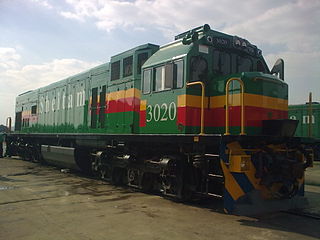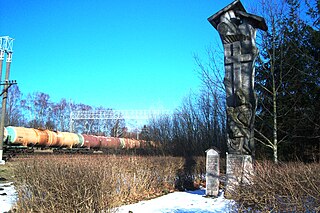
The Summit Tunnel fire occurred on 20 December 1984, when a dangerous goods train caught fire while passing through the Summit Tunnel on the railway line between Littleborough and Todmorden on the Greater Manchester/West Yorkshire border, England.
The Valigonda rail disaster occurred on 29 October 2005 near the town of Valigonda, south of Hyderabad in the Indian state of Andhra Pradesh. A flash flood swept away a small rail bridge, and a "Delta Fast Passenger" train traveling on it derailed at the broken section of the line, killing at least 114 people and injuring over 200.
The Sarai Banjara rail disaster occurred on 2 December 2000, when a derailed freight train crossed onto the opposite track early in the morning in Punjab, India. A Howrah–Amritsar Express a passenger train coming from other direction hit the freight train head-on at speed, killing 46 people and injuring at least 150.
The 2005 Jaunpur train bombing occurred on 28 July 2005, when an explosion destroyed a carriage of Shramjeevi Express train near the town of Jaunpur in Uttar Pradesh.
The railways of New South Wales, Australia have had many incidents and accidents since their formation in 1831. There are close to 1000 names associated with rail-related deaths in NSW on the walls of the Australian Railway Monument in Werris Creek. Those killed were all employees of various NSW railways. The details below include deaths of employees and the general public.
The Dunmurry train bombing was a premature detonation of a Provisional Irish Republican Army (IRA) incendiary bomb aboard a Ballymena to Belfast passenger train service on 17 January 1980.

BOAC Flight 712 was a British Overseas Airways Corporation (BOAC) service operated by a Boeing 707-465 from London Heathrow Airport bound for Sydney via Zurich and Singapore. On Monday 8 April 1968, it suffered an engine failure on takeoff that quickly led to a major fire; the engine detached from the aircraft in flight. After the aircraft had made a successful emergency landing, confusion over checklists and distractions from the presence of a check pilot contributed to the deaths of five of the 127 on board. The direct cause of the fire was the failure of a compressor wheel, due to metal fatigue.

A bushfire season occurred predominantly from June 2009 to May 2010. Increased attention has been given to this season as authorities and government attempt to preempt any future loss of life after the Black Saturday bushfires during the previous season, 2008–09. Long range weather observations predict very hot, dry and windy weather conditions during the summer months, leading to a high risk of bushfire occurrence.
The Marden rail crash occurred on 4 January 1969 near Marden, Kent, United Kingdom, when a passenger train ran into the rear of a parcels train, having passed two signals at danger. Four people were killed and 11 were injured. One person was awarded the British Empire Medal for his part in the aftermath of the collision.

On 1 January 2011, Kolavia Flight 348, a Tupolev Tu-154 on a domestic scheduled passenger flight from Surgut to Moscow, Russia, caught fire and burned down while taxiing out for take-off. Passengers were evacuated, but three were killed and 43 injured. A subsequent investigation concluded that the fire had started in an electric panel for which maintenance was never prescribed.
The Penukonda train collision occurred in the early hours of 22 May 2012, when the Bangalore bound Hampi Express crashed into a stationary freight train near Penukonda, in the Indian state of Andhra Pradesh. The incident killed 25 people while 43 people were injured. Three coaches derailed as a result of the crash while another caught fire. The fire was brought under control and rescue and relief operations started in a couple of hours. Railway Minister Mukul Roy, who was in Kolkata, rushed to the site of the accident and ordered an inquiry into it. Early reports suggested that Hampi Express overshot a signal and collided with a stationary goods train. Roy also announced a compensation of Rs 500,000 to the next of kin of the deceased, Rs 100,000 for those who sustained grievous injuries and Rs 50,000 to those who received minor injuries.
The Nellore train fire occurred on 30 July 2012, when the Chennai-bound Tamil Nadu Express train caught fire at 4:22 am near Nellore, Andhra Pradesh, India. At least 32 passengers died and 27 were injured. The fire gutted the S-11 sleeper coach in 20 minutes. A railway emergency crew prevented the fire from spreading to the other coaches.

On 4 January 2018, a passenger train operated by Shosholoza Meyl collided with a truck at a level crossing at Geneva Station between Hennenman and Kroonstad, in the Free State, South Africa. The train derailed, and seven of the twelve carriages caught fire. Twenty-one people were killed and 254 others were injured.

Žasliai railway disaster occurred on 4 April 1975 near Žasliai, Lithuanian SSR. A passenger train on Vilnius–Kaunas Railway hit a tank car carrying fuel. The passenger train derailed and caught fire. Soviet authorities suppressed the news of the disaster and there are persistent rumors that the official death toll of 20 dead and 80 injured is understated, but it remains the largest railway accident in Lithuania.

On 31 October 2019, Pakistan Railways' Tezgam passenger train caught fire while traveling from Karachi to Rawalpindi, resulting in at least 75 passenger deaths. The train accident was the deadliest in Pakistan since 2005, when the Ghotki rail crash killed more than 100 people. Preliminary evidence suggested the explosion of a portable stove occurred because some passengers illegally cooked food aboard the train. Such use of gas stoves is common on Pakistan's railways; train authorities often turn a blind eye to the dangerous practice. However, an inquiry report revealed in January 2020 that the incident occurred due a short-circuit in the electric wiring of the train, negating earlier reports of a cylinder blast.

On 26 August 2020 a freight train carrying diesel fuel and gas oil in tank wagons derailed at Morlais Junction, Llangennech, Carmarthenshire, Wales. Some of the derailed wagons caught fire, leading to an evacuation of people living nearby. There was widespread contamination from the spilled fuel. The clean-up operation was described by Natural Resources Wales as the most challenging since the Sea Empress oil spill in 1996. The accident was caused by defective brakes on a wagon causing an axle to seize, which in turn caused deformation of the track under the train as it travelled over a set of points. The Heart of Wales Line was closed for seven months as a result of the derailment.